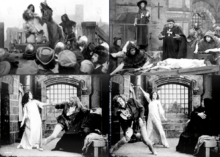The Hunchback of Notre Dame (1911 film)
The Hunchback of Notre Dame was a 1911 French silent film directed by Albert Capellani and produced by Pathé Frères. It was released under the name Notre-Dame de Paris. It starred Henry Krauss and Stacia Napierkowska. The film was based on the 1831 Victor Hugo novel of the same name. Considering the film's brief running time, critic Christopher Workman considered it "remarkably faithful to its source material" but it "contains no discernible humor, unlike most other horror films of the period, and thus represents a bellwether of sorts for the genre....(Henry Krauss as Quasimodo) "looks remarkably like Charles Ogle in (Thomas) Edison's 1910 Frankenstein."[2]
| The Hunchback of Notre Dame | |
|---|---|
 | |
| Directed by | Albert Capellani |
| Produced by | Pathé Frères (as Compagnie Genérale des Établissements Pathé Frères Phonographes & Cinématographes [C.G.P.C.]) |
| Based on | The Hunchback of Notre Dame by Victor Hugo |
| Starring | Henry Krauss Stacia Napierkowska Claude Garry |
| Distributed by | Pathé Frères (France) General Film Company (USA) |
Release date | December, 1911 (USA) |
Running time | 26 minutes[1] |
| Country | France |
| Language | Silent film (English intertitles for USA distribution) |
Although the film vilified organized Christianity by portraying members of the clergy as "sadistic and duplicitous", it was theatrically released in the USA in December 1911, shortly before Christmas.[2]
Plot
Esmeralda, the gypsy, is the darling of the people around Notre Dame Cathedral in Paris. Three men are romantically interested in her: Phöebus, the commander of the city guard, Quasimodo the bell ringer of Notre Dame and Claudius Frollo, the archdeacon of the cathedral. The latter, however, is confused by his strong affection for Esmeralda and cannot resolve the conflict caused by his vow of celibacy. Out of jealousy, he stabs a knife in Phöebus's back when he meets with Esmeralda in an inn. Esmeralda is falsely accused and charged with this crime. The resultant death sentence is to be executed on the forecourt of the cathedral. Quasimodo rescues the gypsy and brings her up into the bell tower to safety but Frollo violates the sanctuary and has Esmeralda executed by hanging. Quasimodo then angrily throws Frollo from the bell tower to his death.
Cast
- Henry Krauss as Quasimodo
- Stacia Napierkowska as Esméralda
- René Alexandre as Phoebus de Châteaupers
- Claude Garry as Claude Frollo
- Jean Angelo
- Paul Capellani
- Jean Dax
- Mévisto
References
- Workman, Christopher; Howarth, Troy (2016). Tome of Terror: Horror Films of the Silent Era. Midnight Marquee Press. p. 85. ISBN 978-1936168-68-2.
- Workman, Christopher; Howarth, Troy (2016). Tome of Terror: Horror Films of the Silent Era. Midnight Marquee Press. p. 86. ISBN 978-1936168-68-2.